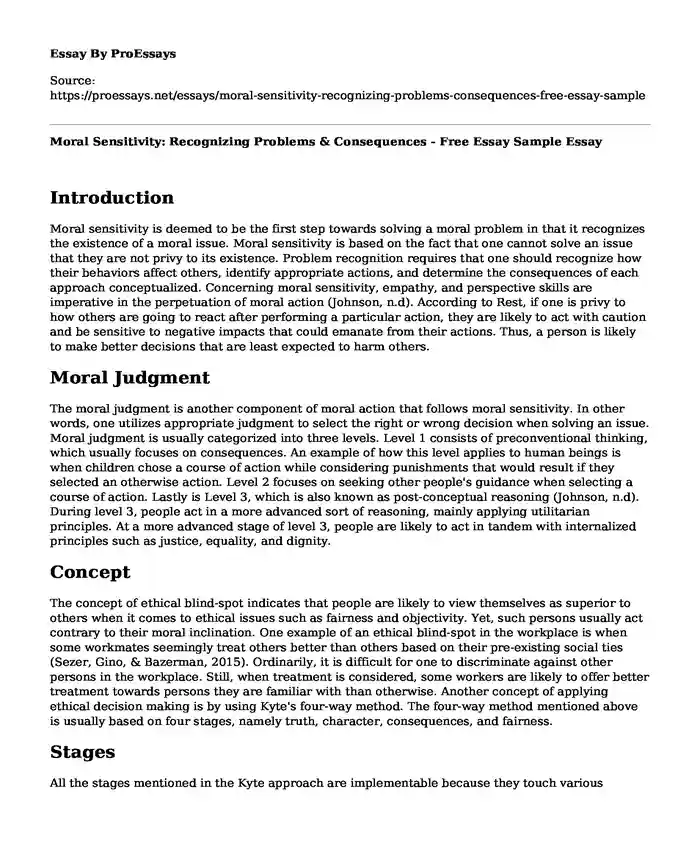Introduction
Moral sensitivity is deemed to be the first step towards solving a moral problem in that it recognizes the existence of a moral issue. Moral sensitivity is based on the fact that one cannot solve an issue that they are not privy to its existence. Problem recognition requires that one should recognize how their behaviors affect others, identify appropriate actions, and determine the consequences of each approach conceptualized. Concerning moral sensitivity, empathy, and perspective skills are imperative in the perpetuation of moral action (Johnson, n.d). According to Rest, if one is privy to how others are going to react after performing a particular action, they are likely to act with caution and be sensitive to negative impacts that could emanate from their actions. Thus, a person is likely to make better decisions that are least expected to harm others.
Moral Judgment
The moral judgment is another component of moral action that follows moral sensitivity. In other words, one utilizes appropriate judgment to select the right or wrong decision when solving an issue. Moral judgment is usually categorized into three levels. Level 1 consists of preconventional thinking, which usually focuses on consequences. An example of how this level applies to human beings is when children chose a course of action while considering punishments that would result if they selected an otherwise action. Level 2 focuses on seeking other people's guidance when selecting a course of action. Lastly is Level 3, which is also known as post-conceptual reasoning (Johnson, n.d). During level 3, people act in a more advanced sort of reasoning, mainly applying utilitarian principles. At a more advanced stage of level 3, people are likely to act in tandem with internalized principles such as justice, equality, and dignity.
Concept
The concept of ethical blind-spot indicates that people are likely to view themselves as superior to others when it comes to ethical issues such as fairness and objectivity. Yet, such persons usually act contrary to their moral inclination. One example of an ethical blind-spot in the workplace is when some workmates seemingly treat others better than others based on their pre-existing social ties (Sezer, Gino, & Bazerman, 2015). Ordinarily, it is difficult for one to discriminate against other persons in the workplace. Still, when treatment is considered, some workers are likely to offer better treatment towards persons they are familiar with than otherwise. Another concept of applying ethical decision making is by using Kyte's four-way method. The four-way method mentioned above is usually based on four stages, namely truth, character, consequences, and fairness.
Stages
All the stages mentioned in the Kyte approach are implementable because they touch various aspects of a leader's subjects (Fletcher, 2017). Concerning the aforementioned ethical approach, a leader should seek to understand the common ethical issue, its legal aspects, and historical events leading to the issue. Thus, any leader who achieves answering the above questions attains the truth regarding the ethical issue. After finding the truth concerning an ethical problem, after that, a leader should result in understanding consequences that are likely to be caused by the ethical issue.
Conclusion
In the consequence stage, a leader should ask questions such as, who will be affected? How are they going to be affected? What are the negative things that are likely to occur? The third stage of the four-way approach is usually linked with fairness (Fletcher, 2017). In that regard, a leader should seek to achieve fairness by performing actions in consideration of how others are likely to be affected. Lastly is the stage of character, which accesses why people perform specific actions. Any leader could increase the credibility of their actions by following all the four stages when conducting their actions.
References
Fletcher, C. (2017). An Ethical Life: A Practical Guide to Ethical Reasoning by Richard Kyte (review). Journal of the Society of Christian Ethics. Philosophy Documentation Center, 37(2), 191-192. 10.1353/sce.2017.0040. https://muse.jhu.edu/article/685075.
Johnson, C.E. (n.d). Meeting the Ethical Challenges of Leadership.
https://full-bookshelf.vitalsource.com/#/books/9781544351674/recent.
Sezer, O, Francesca, G & Max, H.B. (2015). Ethical blind spots: explaining unintentional unethical behavior. Current Opinion in Psychology. Elsevier Ltd. Doi: 10.1016/j.copsyc.2015.03.030. https://www.hbs.edu/faculty/Publication%20Files/Ethical+Blind+Spots_4db0de5b-5177-457d-be51-7f0d5d9f3f12.pdf.
Cite this page
Moral Sensitivity: Recognizing Problems & Consequences - Free Essay Sample. (2023, Nov 01). Retrieved from https://proessays.net/essays/moral-sensitivity-recognizing-problems-consequences-free-essay-sample
If you are the original author of this essay and no longer wish to have it published on the ProEssays website, please click below to request its removal:
- Should the U.S. Government Decriminalize Drugs? - Argumentative Essay
- Strain Theory and Child Abuse Essay
- Essay Sample on Influence of Female Autonomy on the Indian Society
- Essay Sample on Child Abduction
- The Cause of Poverty and the Idea of Dead Capital Essay
- Exploring Ethics & CSR at Volkswagen - Essay Sample
- Book Review Example on The Beast in the Jungle: A Tale of Love and Regret







